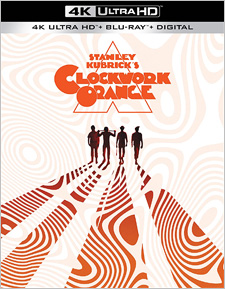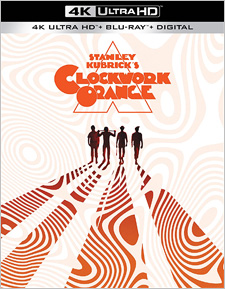Clockwork Orange, A (4K UHD Review)

Director
Stanley KubrickRelease Date(s)
1971 (September 21, 2021)Studio(s)
Polaris Productions/Hawk Films/Warner Bros./Studio Distribution Services (Warner Bros. Home Entertainment)- Film/Program Grade: A
- Video Grade: A-
- Audio Grade: B
- Extras Grade: B-
Review
[Editor’s Note: This review is written in “Nadsat” by Todd Doogan (the film portion, from his 2001 DVD review) with Bill Hunt (the 4K UHD portions). Online dictionaries are available.]
Oh my brothers, it should be said that of all of Stanley Kubrick’s sinny, A Clockwork Orange is probably the most dorogoy. It’s a movie that crawls right into your guttiwuts, and takes you into a world laced with equal parts uncomfortable laughter and fear. I make no appypolly loggies for my personal affection for A Clockwork Orange, and although it’s not my absolute favorite of Kubrick’s sinny, it’s still up there for me. As uncomfortable as it is to viddy, this film stands as one of the greatest, and most violent, anti-violence movies ever made.
A Clockwork Orange concerns the sadistic (and eventually redemptive) adventures of a futuristic prestoopnik named Alex (Malcolm McDowell) and his fellow droogs, as they entertain themselves with a little of the ultra-violence. Alex and the droogs beat the piss out of a pyahnitsa ded, prevent a devotchka from being raped by battling a rival gang, and then go on to rape a few cheenas themselves. Of course, bad deeds don’t go unpaid, so Alex is soon turned upon by his shaika, and left hanging in the wind. To test a new aversion technology, developed to purge evil thought from the mind, the government makes Alex a guinea pig, sucking out what made Alex... well, Alex... including his love for Beethoven. He’s left to reenter society half the man he was, and face the people he once maligned, who are now after him much the way he was after them. Will Alex stay society’s good son? Or will society destroy him?
Aside from those questions, the one most everyone asks about A Clockwork Orange is: “What exactly is ‘a clockwork orange’ anyway?” It’s never really stated—the film makes no sense of this and it’s such a visual term, that it’s hard to apply common sense to it anyway. But look no further my brothers—the answer is simple, and very metaphorical. The underlying theme of the film (and the book it was based on, by Anthony Burgess) is in the definition of moral freedom. Moral freedom is a human being’s own choice to be able to perform both good and evil at any moment.
This idea manifests itself in the symbolic representation of a “clockwork orange.” In the introduction to his novel, Burgess states that if one “can only perform good or only perform evil, then he is a clockwork orange—meaning that he has the appearance of an organism lovely with color and juice but is, in fact, only a clockwork toy to be wound up by God, or the Devil, or (since this is increasingly replacing both) the Almighty State.” Furthering his thought, Burgess continues to say, “It is as inhuman to be totally good as it is to be totally evil. The important thing is moral choice. Evil has to exist along with good, in order that moral choice may operate.” Of course, moral freedom is never truly attained in the film, because Alex is neither totally good, nor totally evil, but a full mix of both characteristics. This holds true, even after the conditioning Alex goes through. It is true that the Government tries to make Alex totally good through conditioning, but because it’s coerced goodness, moral freedom is not truly achieved.
When it comes to scholarly discussions about A Clockwork Orange, the truth boils down to this—it’s just a very cool movie based on a very cool book. I love watching it, especially with people who have never seen it before. Most people squirm, and look over at me all poogly, as I enjoy the film. I know what happens, I pony the underlying meaning of it. But until they sit through it all, people think it’s just a sick movie with no redemptive elements whatsoever. Those of us in the know, however, can appreciate A Clockwork Orange as the masterstroke it is by both Burgess and Kubrick.
A Clockwork Orange was shot on 35 mm film by cinematographer John Alcott using Mitchell BNC, Newman Sinclair Auto Kino, and Arriflex 35IIC cameras with a variety of spherical lenses. It was finished photochemically at the 1.66:1 aspect ratio for theaters (and that’s the way it’s presented here). For its 50th anniversary, Warner has prodded a new 4K scan and restoration supervised by Kubrick’s former assistant Leon Vitali, featuring color grading for high dynamic range (in HDR10 only). This particular sinny has never looked better, with a strong uptick in resolution and fine detailing, particularly visible in faces and clothing. Grain is light to moderate, but natural at all times. The color palette has always had a somewhat chilly appearance befitting the dystopian setting, but the expanded gamut adds a bit of vibrance and more subtleties, with deeper, detailed blacks and coldly-bold highlights. Kubrick’s work is not to be fillyed with, and Warner’s restoration has served this project well.
The primary zvook option is the same English 5.1 DTS-HD Master Audio mix found on the previous Blu-ray edition, though the original English mono mix is also included in Dolby Digital format. The 5.1 mix widens the soundstage a bit, but the mix is heavily front-biased, with the surrounds mostly employed for ambience and music. Bass is a bit plodding, but every once in a while it hits you right in the yarbles. Dialogue is mostly clean and intelligible, but there’s a malenky bit of tinniness and warble here and there—limitations of the original recordings. The score, which includes several tracks by the old Ludwig van along with electronic arrangements by Wendy Carlos (foreshadowing her efforts on Kubrick’s The Shining), is presented in good fidelity. Additional mixes are available in French, German, Italian, Castilian Spanish, and Latin Spanish in 5.1 Dolby Digital, as well as Polish Voiceover in 2.0 Dolby Digital. Optional subtitles are available in English for the Deaf and Hard of Hearing, French, German for the Hearing Impaired, Italian for the Deaf, Castilian Spanish, Dutch, Simplified Chinese, Cantonese, Latin Spanish, Czech, Danish, Finnish, Hungarian, Norwegian, Polish, and Swedish.
Warner’s Ultra HD release includes the film in 4K on UHD and also 1080p HD on an additional Blu-ray in the packaging (the same 40th Anniversary Edition released back in 2011). The 4K disc itself offers only one extra:
- Audio Commentary by Malcolm McDowell and Nick Redman
But the Blu-ray includes this commentary as well, and also adds the following:
- Still Tickin’: The Return of Clockwork Orange (SD – 43:42)
- Great Bolshy Yarblockos! Making A Clockwork Orange (SD – 28:19)
- Turning Like Clockwork (HD – 26:19)
- Malcolm McDowell Looks Back (HD – 10:30)
- Theatrical Trailer (SD – 1:03)
Some of this material first appeared on the original 2007 Blu-ray release, while the rest of it was produced for the 40th Anniversary Edition. The commentary is pleasantly candid and filled with anecdotes on the production. The featurettes are all dobby and quite comprehensive, though the fact that the 40th Anniversary Edition’s bonus disc is missing is enough to make anyone bezoomy. It means you’re missing out on a pair of fine documentaries: O Lucky Malcolm! and Stanley Kubrick: A Life in Pictures. Would it really have been so hard to include a third disc in the ol’ packiwak just for guffs? You do at least get a code for Digital viddying.
A Clockwork Orange is pure Stanley Kubrick in his prime, a fascinating film experience any way you slice it up, and Warner’s new Ultra HD release offers a choodessny and definitive new image restoration that no 4K biblio should go without. And though it’s a little chintzy extras-like, it’s still a worthy disc to kupet, my brothers, especially if you can find it at a nice mark-down.
- Todd Doogan with Bill Hunt
(Todd prefers not to be found on the Interwebs, much less followed)
(You can follow Bill on social media on Twitter and Facebook)

